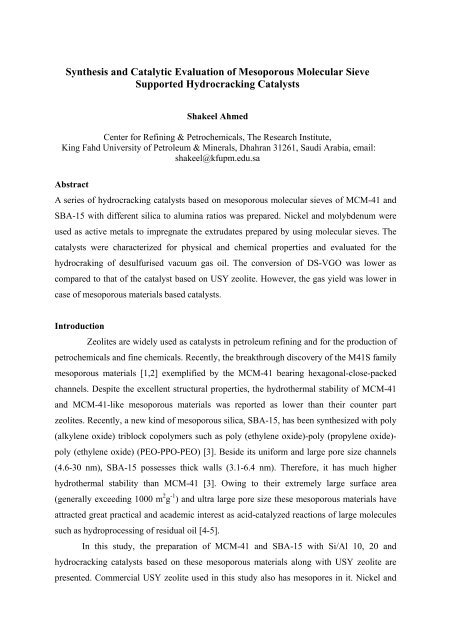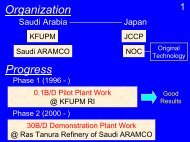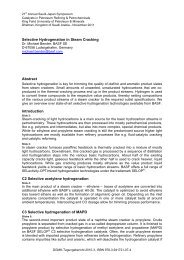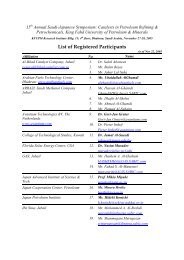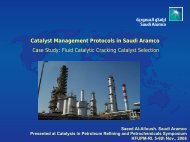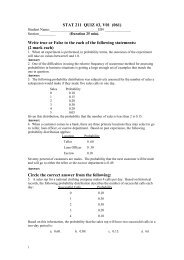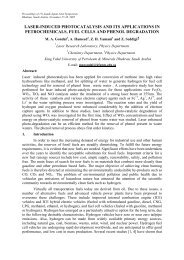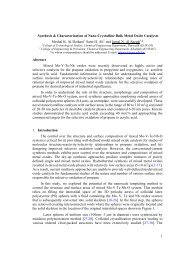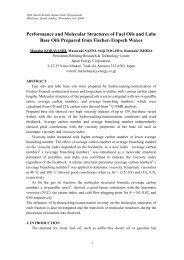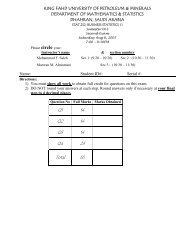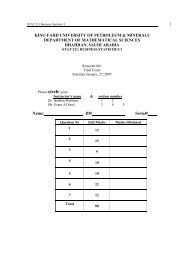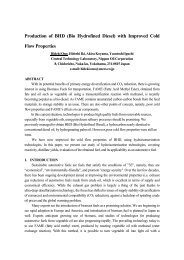preparation of mesoporous molecular sieve based hydrocracking
preparation of mesoporous molecular sieve based hydrocracking
preparation of mesoporous molecular sieve based hydrocracking
Create successful ePaper yourself
Turn your PDF publications into a flip-book with our unique Google optimized e-Paper software.
Synthesis and Catalytic Evaluation <strong>of</strong> Mesoporous Molecular Sieve<br />
Supported Hydrocracking Catalysts<br />
Shakeel Ahmed<br />
Center for Refining & Petrochemicals, The Research Institute,<br />
King Fahd University <strong>of</strong> Petroleum & Minerals, Dhahran 31261, Saudi Arabia, email:<br />
shakeel@kfupm.edu.sa<br />
Abstract<br />
A series <strong>of</strong> <strong>hydrocracking</strong> catalysts <strong>based</strong> on <strong>mesoporous</strong> <strong>molecular</strong> <strong>sieve</strong>s <strong>of</strong> MCM-41 and<br />
SBA-15 with different silica to alumina ratios was prepared. Nickel and molybdenum were<br />
used as active metals to impregnate the extrudates prepared by using <strong>molecular</strong> <strong>sieve</strong>s. The<br />
catalysts were characterized for physical and chemical properties and evaluated for the<br />
hydrocraking <strong>of</strong> desulfurised vacuum gas oil. The conversion <strong>of</strong> DS-VGO was lower as<br />
compared to that <strong>of</strong> the catalyst <strong>based</strong> on USY zeolite. However, the gas yield was lower in<br />
case <strong>of</strong> <strong>mesoporous</strong> materials <strong>based</strong> catalysts.<br />
Introduction<br />
Zeolites are widely used as catalysts in petroleum refining and for the production <strong>of</strong><br />
petrochemicals and fine chemicals. Recently, the breakthrough discovery <strong>of</strong> the M41S family<br />
<strong>mesoporous</strong> materials [1,2] exemplified by the MCM-41 bearing hexagonal-close-packed<br />
channels. Despite the excellent structural properties, the hydrothermal stability <strong>of</strong> MCM-41<br />
and MCM-41-like <strong>mesoporous</strong> materials was reported as lower than their counter part<br />
zeolites. Recently, a new kind <strong>of</strong> <strong>mesoporous</strong> silica, SBA-15, has been synthesized with poly<br />
(alkylene oxide) triblock copolymers such as poly (ethylene oxide)-poly (propylene oxide)-<br />
poly (ethylene oxide) (PEO-PPO-PEO) [3]. Beside its uniform and large pore size channels<br />
(4.6-30 nm), SBA-15 possesses thick walls (3.1-6.4 nm). Therefore, it has much higher<br />
hydrothermal stability than MCM-41 [3]. Owing to their extremely large surface area<br />
(generally exceeding 1000 m 2 g -1 ) and ultra large pore size these <strong>mesoporous</strong> materials have<br />
attracted great practical and academic interest as acid-catalyzed reactions <strong>of</strong> large molecules<br />
such as hydroprocessing <strong>of</strong> residual oil [4-5].<br />
In this study, the <strong>preparation</strong> <strong>of</strong> MCM-41 and SBA-15 with Si/Al 10, 20 and<br />
<strong>hydrocracking</strong> catalysts <strong>based</strong> on these <strong>mesoporous</strong> materials along with USY zeolite are<br />
presented. Commercial USY zeolite used in this study also has mesopores in it. Nickel and
molybdenum are impregnated as active metals. Mesoporous materials and <strong>hydrocracking</strong><br />
catalysts prepared were characterized by XRD, surface are, pore volume, pore-size<br />
distribution, particle size measurement, and acidity measurement by FTIR and ammonia<br />
TPD. The side crushing strength <strong>of</strong> the extrudates with alumina binder was also measured by<br />
crushing strength tester. The catalysts were evaluated for <strong>hydrocracking</strong> <strong>of</strong> desulfurized<br />
vacuum gas oil (DS-VGO). The <strong>hydrocracking</strong> activity was measured by GC-SIMDIST<br />
method and sulfur and nitrogen contents <strong>of</strong> the product were measured by elemental<br />
analyzer.<br />
Experimental<br />
Synthesis <strong>of</strong> Mesoporous Molecular Sieves.<br />
Synthesis <strong>of</strong> Al-MCM-41 was followed by the procedure described by Kim and coworkers<br />
[6]. Two samples were prepared with Si/Al ratio <strong>of</strong> 10 and 20. A pure silica SBA-15<br />
has been synthesized following a procedure <strong>of</strong> Stuky and co-workers [5] with some<br />
variations adopted by Cheng et.al., [7]. Al-SBA-15 was obtained by treating pure silica<br />
sample with predetermined amount <strong>of</strong> aluminum isoperoxide in a solution <strong>of</strong> n-hexane to get<br />
Si/Al ratios <strong>of</strong> 10 and 20. The Al-MCM-41 and Al-SBA-15 samples were calcined in air at<br />
500 °C for 5 h and then ion-exchanged with 0.1 M solution <strong>of</strong> HNO 3 for 3-4 days, changing<br />
fresh HNO 3 solution twice every day. Final calcination <strong>of</strong> the ion-exchanged sample was<br />
carried out in air at 500 °C for 5 h to obtain H-type <strong>of</strong> Al-MCM-41 and Al-SBA-15.<br />
Catalyst Preparation.<br />
Extrudates <strong>of</strong> 50% zeolitic materials and alumina binder (Cataloid AP-1, supplied by CCIC<br />
<strong>of</strong> Japan) were prepared in 1/32 inch <strong>of</strong> diameter. USY zeolite HSZ-330 HOA was supplied<br />
by Tosoh Company, Japan. The typical <strong>preparation</strong> procedure was as follows: 7.00 g <strong>of</strong><br />
zeolite was mixed with 9.86 g <strong>of</strong> alumina binder (71% Al 2 O 3 ) in a Teflon beaker with<br />
stainless steel spatula. After through mixing <strong>of</strong> the two solid 14.0 g <strong>of</strong> distilled water was<br />
added drop wise with constant mixing. After kneading the mixture was loaded into a steel<br />
syringe (20 ml) with a 1/32” dice and extrudates were obtained with the help <strong>of</strong> oil jack. The<br />
amount <strong>of</strong> water varied for various <strong>mesoporous</strong> materials. The extrudates prepared were<br />
dried in oven at 120 ºC for 2 hours and calcined in dry flowing air for 2 hours at 550 ºC in a<br />
quartz tube in horizontal muffle furnace. The calcined extrudates were stored in screw<br />
capped glass bottles.
Hexaammonium hepatmolybdate tetrahydrate (99.05, Kanto Chemical Co., Japan)<br />
and nickel nitrate hexahydrate (98.0%, Junsei Chemical Co., Japan) were used as sources for<br />
molybdenum and nickel, for loading on to the extrudates, respectively. Incipient wetness<br />
method was used for the impregnation <strong>of</strong> metals on the extrudates. Molybdenum was<br />
impregnated first followed by nickel impregnation. In between two successive impregnations<br />
the catalyst samples were dried and calcined up to 550 ºC for 2 hours. Finally the catalyst<br />
samples were dried in flowing air and calcined at 550 ºC for 2 hours.<br />
Characterization Methods.<br />
The BET surface area and pore volume <strong>of</strong> all the catalysts were measured by an Autosorb-1<br />
gas sorption analyzer (Quantachrome Corporation, USA) using nitrogen at 77 K. The particle<br />
size measurement was performed by Photal DLS-6000 HL instrument, supplied by Otsuka<br />
Electronics <strong>of</strong> Japan. A 10 mg sample <strong>of</strong> <strong>mesoporous</strong> <strong>molecular</strong> <strong>sieve</strong> was dispersed in 10 ml<br />
<strong>of</strong> distilled water. The sample was treated in an ultrasonic bath for five minutes for better<br />
dispersion. The measurement results are reported as a particle size diameter <strong>of</strong> number<br />
averaged distribution. The acid properties <strong>of</strong> <strong>hydrocracking</strong> catalysts were determined by<br />
temperature-programmed desorption <strong>of</strong> ammonia. The system was supplied by Bell Japan<br />
Inc. (Model TPD-1-A). FTIR analyses <strong>of</strong> pyridine adsorbed <strong>mesoporous</strong> <strong>molecular</strong> <strong>sieve</strong>s<br />
were performed for the acidity measurement. This technique is utilized for the measurement<br />
<strong>of</strong> Brönsted and Lewis acid sites selectively. Powder X-ray diffraction patterns <strong>of</strong><br />
<strong>mesoporous</strong> <strong>molecular</strong> <strong>sieve</strong>s were recorded on a Rigaku RINT 2400 diffractometer using Cu<br />
Kα radiation.<br />
Catalyst Evaluation.<br />
Hydrocracking activity <strong>of</strong> four catalyst samples was measured in fixed bed micro flow<br />
reactor under mild <strong>hydrocracking</strong> conditions. Desulfurized vacuum gas oil (DS-VGO) feed<br />
was used for the <strong>hydrocracking</strong> reaction. Properties <strong>of</strong> feedstock and reaction condition are<br />
summarized as follows:<br />
Feedstock: DS-VGO<br />
Density 15°C 0.8819 g/cm 3<br />
Nitrogen<br />
0.017 wt%<br />
Sulfur<br />
0.01 wt%
Reaction condition:<br />
Temperature 370 °C<br />
Pressure 80 kg/cm 2<br />
LHSV 1.0 h -1<br />
Hydrogen flux 10NL/h<br />
H 2 /Oil<br />
1000 L/L<br />
Reaction Time 7 h<br />
In a typical run, 10 cc <strong>of</strong> the catalysts extrudates (1/32 in) were loaded in a stainless<br />
steel tube reactor (capacity 10 cc) placed in a sand bath. All the catalysts were sulfided in a<br />
flow <strong>of</strong> 5% H 2 S for two hours at 400 °C. Then the reactor was cooled to the reaction<br />
temperature i.e., 370 °C. The feed was introduced at a rate <strong>of</strong> 10 cc/h and the product sample<br />
was collected after seven hours. The product tank was purged twice before collecting a two<br />
hour sample <strong>of</strong> gas and liquid separately. The liquid product was analyzed by simulated gas<br />
chromatography to calculate the conversion <strong>of</strong> DS-VGO. The conversion was calculated as<br />
weight fraction < 343 °C.<br />
Results and Discussion<br />
The results <strong>of</strong> surface area, pore volume, pore size, and particle size, and TPD <strong>of</strong><br />
ammonia <strong>of</strong> <strong>mesoporous</strong> materials are summarized in the following Table 1.<br />
Table 1. Physical properties <strong>of</strong> <strong>mesoporous</strong> <strong>molecular</strong> <strong>sieve</strong>s<br />
Sample S.A<br />
(m 2 /g)<br />
P.V<br />
(cc/g)<br />
b Pore<br />
Dia. (Å)<br />
Particle Size<br />
(μm)<br />
Acidity<br />
(mmol/g)<br />
MCM-41(10) a 781 0.864 24.4 1.82 ±0.18 0.34<br />
MCM-41(20) 990 0.884 27.2 1.40 ±0.22 0.25<br />
SBA-15 (10) c 555 0.823 77.1 1.73 ±0.12 0.36<br />
SBA-15 (20) 636 0.890 77.7 1.50 ±0.13 0.25<br />
USY-Zeolite 609 0.365 10.5 - 1.37<br />
a. Value in the parenthesis is Si/Al ratio<br />
b. BJH Method Adsorption Pore Diameter<br />
c. Average particle size <strong>of</strong> SBA-15 as-synthesized form = 1.60 ±0.11<br />
The above results show that all the samples have high surface area however the highest is for<br />
MCM-41 (20), on the other hand minimum value is for SBA-15 (10). These results also show<br />
that for same type <strong>of</strong> material, the sample with high silica to alumina ratio exhibits higher<br />
surface area as compared with the samples with lower silica to alumina ratios. This could be<br />
attributed to the lower crystallinity observed by the XRD results. Similarly, pore volume <strong>of</strong>
these materials is very large as compared with USY zeolite. Large pore volume and pore<br />
diameter is required for heavy oil applications. The results <strong>of</strong> acidity measurement show that<br />
the amount <strong>of</strong> acidity depends upon the Si/Al ratio <strong>of</strong> <strong>mesoporous</strong> <strong>molecular</strong> <strong>sieve</strong>s<br />
regardless <strong>of</strong> the type <strong>of</strong> material. However, the amount <strong>of</strong> acidity is fairly low for<br />
<strong>mesoporous</strong> <strong>molecular</strong> <strong>sieve</strong> as compared with that <strong>of</strong> commercial USY zeolite. Figure 1<br />
shows the XRD patter <strong>of</strong> SBA-15 samples. The unit cell size for SBA-15 types <strong>of</strong> materials<br />
are quite larger as compare with MCM-41 type (40.1 Å for Si/Al 10 and 43.3 for Si/Al 20)<br />
<strong>molecular</strong> <strong>sieve</strong>s.<br />
4000<br />
3000<br />
(a) Si/Al 20, (b) Si/Al 10, (c) As-Synth.<br />
Intensity (cps)<br />
2000<br />
1000<br />
(a)<br />
(b)<br />
(c)<br />
0<br />
0 2 4 6 8 10 12<br />
Two theta/Degree<br />
Figure 1 Powder x-ray diffraction pattern <strong>of</strong> SBA-15.<br />
Physical and catalytic properties <strong>of</strong> selected prepared <strong>hydrocracking</strong> catalysts are<br />
given in Table 2. Initial <strong>hydrocracking</strong> activity <strong>of</strong> four catalyst samples was measured in a<br />
fixed bed micro flow reactor (10 cm 3 catalyst volume) at 370 ºC and 80 kg/cm 2 for seven<br />
hours at a liquid hourly space velocity <strong>of</strong> 1.0 h -1 . Desulfurized vacuum gas oil (DS-VGO)<br />
feed was used for the <strong>hydrocracking</strong> reaction. The results <strong>of</strong> <strong>hydrocracking</strong> activity indicate<br />
that a lower gas yield was obtained with <strong>mesoporous</strong> <strong>molecular</strong> <strong>sieve</strong> <strong>based</strong> catalysts as
compared with USY zeolite base catalyst. However, highest cracking activity was observed<br />
with USY <strong>based</strong> catalyst. This is due to very high acidity <strong>of</strong> USY zeolite as compared with<br />
other materials used in this study. The liquid yield was very low (40%) in case <strong>of</strong> Catalyst-D<br />
as compared with (above 95%) other catalysts. The overall results show that <strong>mesoporous</strong><br />
<strong>molecular</strong> <strong>sieve</strong>s have potential to be used as <strong>hydrocracking</strong> catalysts.<br />
Table 2.<br />
Sample<br />
Code<br />
Physical and catalytic properties <strong>of</strong> prepared catalysts<br />
Support *<br />
S.A<br />
(m 2 /g)<br />
Pore<br />
Vol.<br />
(cc/g)<br />
Bulk<br />
density<br />
(g/cc)<br />
DS-<br />
VGO<br />
Con.<br />
(%)<br />
Gas<br />
yield<br />
(wt. %)<br />
Cat-A MCM-41 340 0.353 0.604 54.0 4.43<br />
(10)<br />
Cat-B SBA-15 253 0.416 0.526 21.2 1.33<br />
(10)<br />
Cat-C SBA-15 298 0.464 0.555 19.8 1.59<br />
(20)<br />
Cat-D USYzeolite<br />
292 0.290 0.694 92.2 15.6<br />
*50% mixture <strong>of</strong> H-form <strong>of</strong> Al- zeolitic material and alumina binder, impregnated<br />
with 10% MoO 3 and 4% NiO.<br />
Conclusions<br />
Mesoporous <strong>molecular</strong> <strong>sieve</strong>s <strong>of</strong> MCM41 and SBA-15 type have been synthesized<br />
successfully with Si/Al ratios <strong>of</strong> 10 and 20. The results <strong>of</strong> characterization <strong>of</strong> these material<br />
reveals the structure and other properties are <strong>of</strong> typical <strong>mesoporous</strong> material. Catalyst <strong>based</strong><br />
on USY zeolite showed highest <strong>hydrocracking</strong> activity. MCM-41(10) <strong>based</strong> catalyst also<br />
showed good catalytic activity. On the other hand catalysts <strong>based</strong> on SBA-15 showed lower<br />
activity. However gas yield was higher and liquid yield was very low for USY zeolite <strong>based</strong><br />
catalyst as compared with MCM-41 <strong>based</strong> catalyst.<br />
Acknowledgement.<br />
The author wishes to acknowledge the support <strong>of</strong> the Research Institute, King Fahd<br />
University <strong>of</strong> Petroleum & Minerals, in carrying out this research.<br />
References<br />
1. Kresge, C.T., Leonowicz, M. E., Roth, W. J., Vartuli, J. C., Beck, J. S., Nature, 1992,<br />
359, p. 710.
2. Beck, J. S., Vartuli, J. C., Roth, W. J., Leonowicz, M. E., Kresge, C.T., Schmitt, K. D.,<br />
Chu, C.T. –W., Olson, D.H., Sheppard, E.W., McCullen, S.B., Higgins, J.B.,<br />
Schlenker, J.L., J. Am. Chem. Soc., 1992, 114, p. 10834.<br />
3. Corma, A., Grande, M. S., Gonzalez-Alfaro, V., and Orchilles, A. V., J. Catal., 1996,<br />
159, p. 375.<br />
4. Sayari, A., Chem. Mater., 1996, 8, p. 1840.<br />
5. Zaho, D., Feng, J., Huo, Q., Melosh, N., G. H. Fredrickson, B. F. Chmelka, and G. D.<br />
Stuky, Science, 1998, 279, p.548.<br />
6. Kim, J.M., Kwak, J.A., Jun, S., and Ryoo, R., J. Phys. Chem., 1995, 99, p. 16742-47.<br />
7. Cheng, M., Wang, Z., Sakurai, K., Kumata, F., Saito, T.,.Komatsu, T., and Yashima,<br />
T., Chem.Lett., 1999, 2, 131-132.


